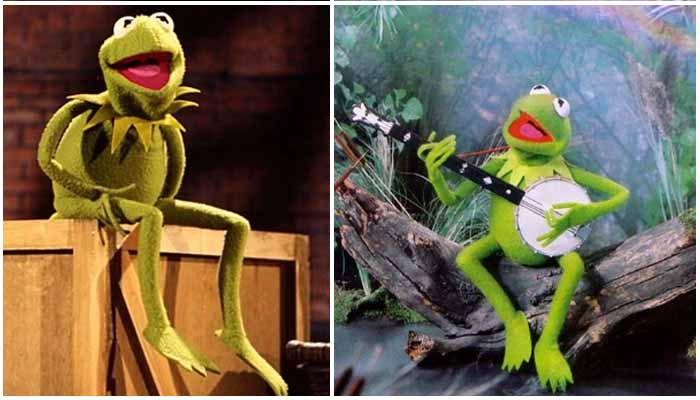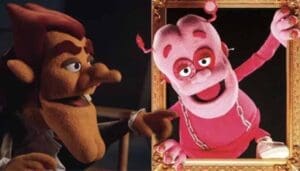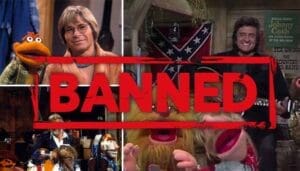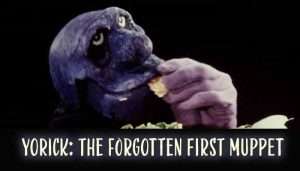For decades, a certain green frog with a perpetually optimistic outlook has hopped his way into the hearts of millions across the globe. Kermit the Frog, more than just a puppet, stands as a cultural icon, a symbol of childhood wonder, and a testament to the enduring power of creativity. From his humble beginnings crafted from a discarded coat to his status as a celebrated figure in television and film, Kermit’s journey is a fascinating tale of innovation, collaboration, and timeless appeal. This article will delve into the complete history and legacy of this beloved amphibian, exploring his creation by the visionary Jim Henson, his pivotal roles in groundbreaking television shows, his adventures on the silver screen, his profound impact on popular culture, and the reasons why he continues to enchant audiences generation after generation.
From a Mother’s Coat to the Small Screen: The Genesis of Kermit
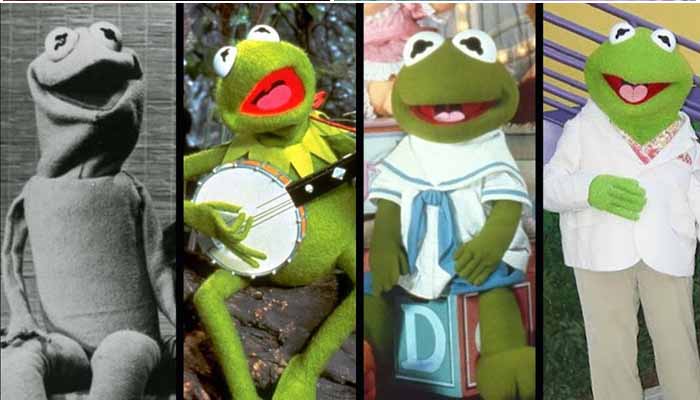
The story of Kermit the Frog begins with the remarkable talent and vision of Jim Henson. Henson, a puppeteer with an early and abiding interest in the art form, would go on to create an entire universe of memorable characters, but it was Kermit who would become his most famous creation. The very first iteration of Kermit emerged in 1955 for a local television show in Washington, D.C., titled “Sam and Friends”. This prototype Kermit was ingeniously crafted from simple, everyday materials: a discarded turquoise spring coat belonging to Henson’s mother and two ping pong ball halves for eyes. Interestingly, this initial version bore a closer resemblance to a lizard than the frog we know today.
“Sam and Friends” was a brief, five-minute puppet show that aired twice daily on WRC-TV. The show featured a cast of hand puppets, brought to life by Henson and his future wife Jane Nebel, often lip-synching to popular songs or comedy records. This early work marked Henson’s initial foray into television puppetry, a medium where he would later revolutionize the art form. Henson’s choice of softer, more flexible materials like foam rubber for his puppets, starting with Kermit, was a significant departure from traditional wooden puppets. This innovation allowed for a greater range of expressive movements, which became a defining characteristic of the Muppets’ appeal and contributed significantly to Kermit’s development as a believable character. The transformation of Kermit from a lizard-like puppet to his eventual frog form illustrates the iterative process of character design, a testament to Henson’s evolving vision for his creations.
Becoming a Frog and Finding His Voice: Kermit on Sesame Street
Around 1969, prior to his debut on “Sesame Street,” Kermit officially transitioned into the frog we recognize today. A distinctive triangular-pointed collar was added to his design at this time, primarily to make him appear more frog-like and to cleverly conceal the seam between his head and body. This marked a significant step in solidifying Kermit’s visual identity.
In the same year, 1969, Kermit joined the groundbreaking children’s educational program “Sesame Street” as one of its original main Muppet characters. It was through “Sesame Street” that Kermit’s fame truly blossomed. On the show, he often appeared in the role of a lecturer, explaining simple concepts to young viewers. He also frequently played the role of the straight man, reacting with bemused patience to the antics of other beloved Muppets like Grover and Cookie Monster. One of his most memorable roles on “Sesame Street” was as the intrepid news reporter for “Sesame Street News,” where he would hilariously interview Muppet versions of characters from fairy tales and nursery rhymes. Segments like the “Sesame Street News Flash” became iconic parts of the show. Kermit also contributed his musical talents to the program, singing many memorable songs, including the now-classic “Bein’ Green”.
Kermit’s segments on “Sesame Street” held significant educational value, teaching children fundamental skills such as reading and counting, as well as introducing them to various concepts in an engaging and accessible way. Research has even indicated that “Sesame Street” had a positive impact on children’s school readiness. Interestingly, unlike the other Muppets on “Sesame Street,” Kermit was never owned by Sesame Workshop; he remained a property of Jim Henson (now The Walt Disney Company). Kermit’s presence on “Sesame Street” established him as a relatable and trustworthy figure for young audiences, effectively using the charm of puppets for educational purposes. The contrast between his mild-mannered and nurturing persona on “Sesame Street” and his more frazzled demeanor on “The Muppet Show” highlights the versatility of the character and Henson’s skill in adapting him to different contexts. This difference in portrayal likely stemmed from the distinct goals of each show: education for “Sesame Street” and broad family entertainment for “The Muppet Show.”
“It’s Time to Start the Music!”: Kermit as the Heart of The Muppet Show
In 1976, Kermit took on his defining role as the host and showrunner of “The Muppet Show”. As the pragmatic everyman, Kermit constantly found himself trying to maintain order amidst the hilarious chaos created by the show’s eccentric cast of Muppets. Jim Henson himself drew a parallel between Kermit’s role and his own experiences managing a large and often unpredictable group of performers.
Kermit’s interactions with the other Muppets were central to the show’s comedic dynamic. His tumultuous and often one-sided romantic pursuit by the glamorous pig, Miss Piggy, became a beloved running gag. His exasperated attempts to support the often-failing comedic endeavors of Fozzie Bear provided another rich source of humor. And his bewildered reactions to the bizarre stunts and pronouncements of Gonzo further contributed to the show’s unique charm.
“The Muppet Show” was structured as a variety sketch comedy, featuring recurring sketches and musical numbers. The episodes were interspersed with ongoing plotlines and running gags that unfolded backstage and in other areas of the Muppet Theater. A key element of the show’s success was the inclusion of a different celebrity guest star each week, many of whom were eager to share the stage with the Muppets.
“The Muppet Show” had a profound impact on popular culture. It garnered a global audience, reaching over 100 countries. The show masterfully blended lighthearted humor with insightful social commentary , appealing to both children and adults with its multi-layered entertainment. Its popularity led to numerous movies, books, and a wide array of merchandise. Furthermore, “The Muppet Show” is credited with revolutionizing puppetry on television, bringing a new level of artistry and sophistication to the medium. Kermit’s central role in the chaotic yet endearing world of “The Muppet Show” deeply resonated with audiences who could identify with his efforts to maintain composure amidst absurdity. His “everyman” persona provided a relatable anchor for viewers navigating the show’s often-outlandish scenarios. The show’s success demonstrated Henson’s remarkable ability to create entertainment that appealed to a broad audience, a formula that has since been adopted by many other successful franchises.
Kermit Goes to Hollywood (and Beyond): His Film and Special Appearances
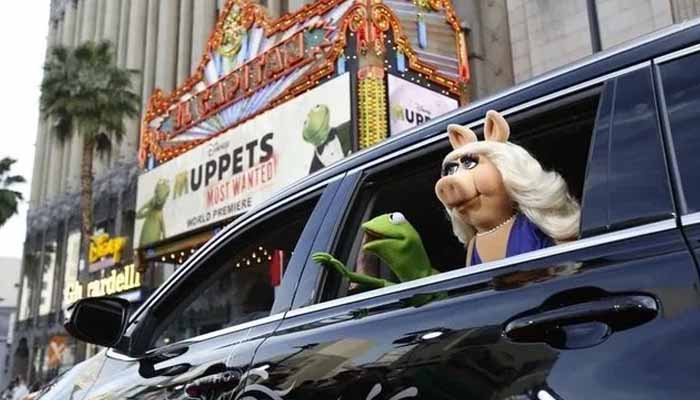
Kermit’s popularity extended beyond the small screen, leading him to star in numerous Muppet movies. In “The Muppet Movie” (1979), he embarked on a journey to Hollywood, seeking fame and fortune, and along the way, he introduced his signature song, “Rainbow Connection”. “The Great Muppet Caper” (1981) saw him in the role of an investigative reporter alongside Fozzie and Gonzo. In “The Muppets Take Manhattan” (1984), Kermit and the gang aimed to bring their show to Broadway. He took on the classic role of Bob Cratchit in “The Muppet Christmas Carol” (1992) and portrayed Captain Abraham Smollett in “Muppet Treasure Island” (1996). “Muppets from Space” (1999) featured Kermit and his friends searching for Gonzo’s alien relatives. In the 2011 film “The Muppets,” Kermit played a pivotal role in reuniting the disbanded Muppet troupe , while “Muppets Most Wanted” (2014) involved him being mistaken for an international criminal doppelganger.
Beyond movies, Kermit also graced numerous television specials , including “Hey, Cinderella!” (1969) , “The Frog Prince” (1971) , “Emmet Otter’s Jug-Band Christmas” (1977) , and “A Muppet Family Christmas” (1987). Across these various productions, Kermit’s character often served as the optimistic leader, the relatable straight man, or a combination of both. While his core personality remained consistent, there have been varying interpretations of his behavior and emotional range throughout the years. Kermit’s consistent presence as the central figure in most Muppet films and specials underscores his crucial role as the heart of the entire franchise. The evolution of his design from the early lizard-like puppet to the established frog appearance by the time of “Hey Cinderella!” marked a significant turning point in his visual identity, solidifying the look that would become iconic for decades.
More Than Just a Puppet: Kermit’s Lasting Cultural Imprint
Kermit the Frog’s influence extends far beyond the realm of mere entertainment. He and the Muppets have significantly impacted comedy through their unique blend of satire, slapstick, and self-referential humor. Even in the modern digital age, Kermit’s comedic relevance is evident in the enduring popularity of the “But That’s None of My Business” internet meme.
Jim Henson’s innovative puppetry techniques, with Kermit as a prime example, helped elevate puppetry from a niche children’s pastime to a respected and influential art form within the broader entertainment industry. Kermit’s expressive design and the skill of his puppeteers in conveying subtle emotions played a crucial role in this transformation.
Kermit has also left an indelible mark on children’s entertainment, particularly through his prominent role on “Sesame Street”. He became a beloved figure who imparted valuable lessons to generations of young viewers. Kermit’s significant contributions to popular culture have been recognized through various accolades, including a well-deserved star on the Hollywood Walk of Fame. Kermit’s influence extends beyond mere entertainment, fundamentally shaping the way puppets are utilized in media and making substantial contributions to children’s education. Henson’s groundbreaking work with puppetry, combined with Kermit’s relatable and engaging personality, broke down traditional perceptions and allowed puppets to be embraced as powerful tools for storytelling and education on a grand scale. The continued presence of Kermit in internet memes and various aspects of popular culture underscores his enduring relevance and his ability to adapt to new forms of media and communication. His iconic image and expressions lend themselves perfectly to the meme format, enabling him to connect with contemporary audiences and remain a vital part of online humor.
Why We Still Love Him: The Timeless Appeal of Kermit
Kermit the Frog’s enduring appeal lies in his remarkable relatability to audiences of all ages. As the often-frazzled “everyman” navigating the chaotic world of the Muppets, he embodies the everyday struggles of balancing work, relationships, and personal aspirations. Despite the absurdity surrounding him, Kermit maintains a sense of optimism and perseverance, qualities that resonate with viewers. For many, Kermit evokes a strong sense of nostalgia, connecting them to cherished childhood memories. His stories often explore universal themes of friendship, the pursuit of dreams, and overcoming challenges, making him a character that transcends age and cultural barriers. Kermit’s enduring appeal stems from his ability to be both ordinary and extraordinary, allowing viewers to simultaneously identify with his struggles and admire his unwavering spirit. His flaws and moments of frustration make him feel human-like, while his underlying optimism and determination serve as an inspiration. The Muppets’ willingness to experiment and appeal to a diverse audience, with Kermit often leading the way, has been crucial to their sustained popularity.
The Voices Behind the Legend: The Performers Who Brought Kermit to Life
The voice and personality of Kermit the Frog have been masterfully brought to life by a select group of talented performers. Jim Henson himself was the original voice and soul of Kermit, portraying him from his creation in 1955 until his untimely passing in 1990. The connection between Henson and Kermit was so profound that many considered the frog to be Henson’s alter-ego.
Following Henson’s death, veteran Muppet performer Steve Whitmire took on the role, voicing Kermit from 1990 to 2016. Whitmire diligently worked to maintain the consistency of the beloved character. Since 2017, Matt Vogel has been the performer behind Kermit, aiming to capture a vocal quality closer to that of Jim Henson. Additionally, Frank Welker provided the voice for Baby Kermit in the animated series “Muppet Babies”. The transition of voice actors underscores the enduring nature of Kermit beyond a single performer, while each has brought their unique contributions to the role. Fan reactions to changes in voice actors, often discussed online, highlight the deep emotional connection audiences have with Kermit’s voice and character, emphasizing the importance of maintaining consistency in his portrayal.
Table 1: Key Voice Actors of Kermit the Frog
| Performer Name | Years of Portrayal | Notable Productions |
|---|---|---|
| Jim Henson | 1955-1990 | The Muppet Show, Sesame Street, The Muppet Movie |
| Steve Whitmire | 1990-2016 | The Muppet Christmas Carol, Muppets Tonight |
| Matt Vogel | 2017-present | Muppets Now, Muppets Haunted Mansion |
| Frank Welker | 1984-1991 | Muppet Babies (voice of Baby Kermit) |
“Rainbow Connection” and Words of Wisdom: Kermit’s Notable Quotes and Songs
Kermit the Frog has contributed some truly iconic songs to popular culture. “Rainbow Connection” from “The Muppet Movie” stands out as a timeless anthem of hope and dreams. His heartfelt rendition of “(It’s Not Easy) Bein’ Green” resonates with themes of self-acceptance. Other notable songs include the cheerful “Movin’ Right Along” and the tender “The First Time It Happens”.
Beyond his musical contributions, Kermit has also delivered many memorable quotes that have become part of popular culture. His simple yet profound wisdom shines through in lines like, “It’s nice to be important, but it’s important to be nice” and “Life’s like a movie. Write your own ending”. The opening lines of his signature song, “Someday we’ll find it, that rainbow connection…” , encapsulate his optimistic spirit. Even his acknowledgment of his unique identity, “It’s not easy bein’ green” , has become a widely recognized sentiment. And his humorous advice, “Beware of advice from experts, pigs and members of Parliament” , reflects his down-to-earth charm. Kermit’s songs often carry messages of hope, dreams, and self-acceptance, contributing to his positive influence on audiences. “Rainbow Connection,” in particular, has become an enduring anthem for dreamers. His memorable quotes often reflect his gentle humor and inherent wisdom, making him a source of both inspiration and lightheartedness.
Table 2: Kermit the Frog’s Filmography (Key Roles)
| Film Title | Year of Release | Kermit’s Role |
|---|---|---|
| The Muppet Movie | 1979 | Protagonist, seeking Hollywood dreams |
| The Great Muppet Caper | 1981 | Investigative Reporter |
| The Muppets Take Manhattan | 1984 | Trying to get a show on Broadway |
| The Muppet Christmas Carol | 1992 | Bob Cratchit |
| Muppet Treasure Island | 1996 | Captain Abraham Smollett |
| Muppets from Space | 1999 | Himself, supporting Gonzo |
| The Muppets | 2011 | Helping to reunite the Muppets |
| Muppets Most Wanted | 2014 | Himself, dealing with an evil doppelganger |
Conclusion: A Frog for All Time
From his humble beginnings as a simple puppet crafted from a coat to his current status as a global icon, Kermit the Frog’s journey is a remarkable testament to the power of creativity and the enduring appeal of a well-developed character. His pivotal roles in groundbreaking television shows like “Sesame Street” and “The Muppet Show,” his adventures in numerous beloved films, and his profound influence on comedy, puppetry, and children’s entertainment have cemented his place in popular culture history. Kermit’s relatability, his optimistic spirit, and the nostalgic connection he fosters with audiences across generations ensure that his legacy will continue to enchant and inspire for years to come. He is, truly, a frog for all time.

